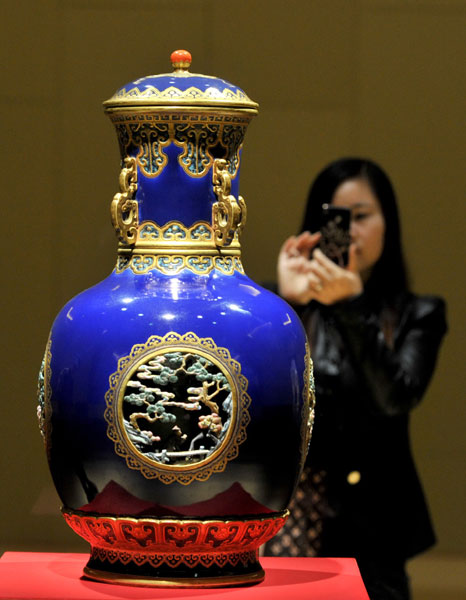

The museum is like a maze and feels much larger than it looks from outside because half of the exhibitions halls are underground. Wandering around the artifacts of Jiangsu, dating as far back as prehistoric times, the abundance forms a narrative that makes me feel like I am watching an epic movie instead of viewing individual potteries, porcelains or figurines scattered in halls. Some are only broken unrestored pieces.
"This museum is designed to show the connections between cultural relics, which are more important than individual exhibits," museum director Gong Liang says.
Some top-tier exhibits, however, deserve their own room. Eighteen pieces, ranked as highlights of the museum, take turns welcoming visitors. The most delicate among this small club: An exquisite 18th-century vase, made with enameling, painting, ivory sculptures and other techniques, features a revolving inner vessel that recreates a vivid hunting scene of Qing Emperor Qianlong (1711-99). The scenario will move when the inner vessel rolls, a marvel that may have foreshadowed the earliest dioramas.
This piece came from 13,000-odd boxes of cultural relics moved from the Forbidden City in the early 1930s to save them from the looming War of Resistance against Japanese Aggression (1937-45). Most were later sent back to Beijing and some were transferred to Taiwan as the cornerstone of the National Palace Museum in Taipei, but more than 2,000 boxes were left in Nanjing. That is why the trio across the Straits, traditionally titled the "big three museums in China" by the public, still share emotional entanglements.
After examining one excellent temporary exhibition after another - old clocks, Buddhist statues and folk art pieces - I decide to explore the underground part. On the way downstairs, I spot many corners installed with the relics' replica with Braille, a thoughtful assistant for visually impaired visitors.
The multimedia hall is my favorite as well as that of children. Children can learn how to restore antiques by playing games on a touch screen, while I can see digital projections of many items which are not on display. A blackboard in the hall provides visitors with space for graffiti. It is a perfect ironical outlet for those who scrawl their names on historical relics.
I am astonished to find a complete community of the 1930's Nanjing that was built underground like a film studio. An old-time trolley, post office and railway station portray the prosperity of China's capital at the time. What surprises me even more is that stores beside the street are not mere settings. Salespeople in long gowns or uniforms of Flying Tigers (voluntary US pilots in China fighting against Japanese invaders during World War II) smile and wave to us, holding souvenirs and showing old books and newspapers published at the time.
Sitting amid the aromas in an old-fashioned cafe, and turning a few pages of the yellowing paper, suddenly, I have a sense that time never passes.
Copyright ©1999-2018
Chinanews.com. All rights reserved.
Reproduction in whole or in part without permission is prohibited.